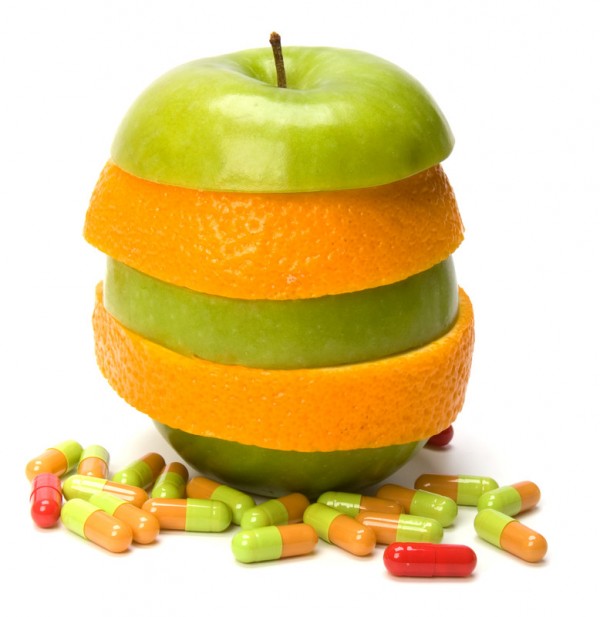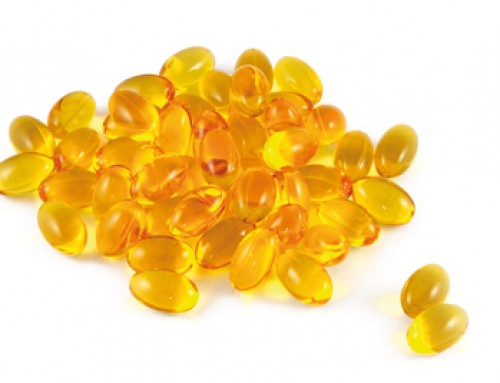VITAMINS AND VITAMIN LIKE SUBSTANCES
Vitamins are a biologically active organic molecules that are an essential micronutrients for the organism. It needs it in small quantities for the proper functioning of its metabolism. They are mostly supplied with food and some are also formed by bacteria in the digestive tract.
FAT SOLUBLE VITAMINS
VITAMIN A
Chemical name (s): all-trans-Retinol, Retinals, and alternative provitamin A-functioning Carotenoids including all-trans-beta-carotene
Main Functions: It has multiple functions: it is important for growth and development, for the maintenance of the immune system, and for good vision.
Allowed health claims (EFSA): Vitamin A
– contributes to normal iron metabolism
– contributes to the maintenance of normal mucous membranes
– contributes to the maintenance of normal skin
– contributes to the maintenance of normal vision
– contributes to the normal function of the immune system
– has a role in the process of cell specialization
Use in cosmetics: Retinyl palmitate has been used in skin creams, where it is broken down to retinol and ostensibly metabolized to retinoic acid, which has potent biological activity. Vitamin A, and more specifically, retinoic acid, appears to maintain normal skin health by switching on genes and differentiating keratinocytes (immature skin cells) into mature epidermal cells.
Deficiency diseases: night blindness, hyperkeratosis, and keratomalacia.
Overdose symptoms: Hypervitaminosis A
Food sources: from animal origin as Vitamin A / all-trans-Retinol: Fish in general, liver, dairy products. From plant origin as provitamin A / all-trans-beta-carotene: orange, ripe yellow fruits, leafy vegetables, carrots, pumpkin, squash, and spinach.
Recommended daily allowance (adults): 800 µg
VITAMIN D
Chemical name (s): Ergocalciferol (Vitamin D2) and Cholecalciferol (Vitamin D3)
Main Functions: It is responsible for increasing intestinal absorption of calcium, magnesium, and phosphate, and multiple other biological effects.
Allowed health claims (EFSA): Vitamin D
– contributes to normal absorption/utilisation of calcium and phosphorus
– contributes to normal blood calcium levels
– contributes to the maintenance of normal bones
– contributes to the maintenance of normal muscle function
– contributes to the maintenance of normal teeth
– contributes to the normal function of the immune system
– has a role in the process of cell division
– helps to reduce the risk of falling associated with postural instability and muscle weakness. Falling is a risk factor for bone fractures among men and women 60 years of age and older.
– is needed for normal growth and development of bone in children.
– contributes to the normal function of the immune system in children.
Deficiency diseases: Rickets and osteomalacia
Overdose symptoms: Hypervitaminosis D
Food sources: Lichen, eggs, liver, certain fish species such as sardines, certain mushroom species such as shiitake. It is also formed in skin exposed to sunlight (ultraviolet rays).
Natural source: The major natural source of the vitamin is synthesis of cholecalciferol (Vitamin D3) in the lower layers of skin epidermis through a chemical reaction that is dependent on sun exposure (specifically UVB radiation).
Recommended daily allowance (adults): 5 µg
VITAMIN K
Chemical name (s): Phylloquinone (Vitamin K1), Menaquinones (Vitamin K2)
Main Functions: The human body requires vitamin K for complete synthesis of certain proteins that are needed for blood coagulation or for controlling binding of calcium in bones and other tissues.
Allowed health claims (EFSA): Vitamin K
– contributes to normal blood clotting
– contributes to the maintenance of normal bones
Deficiency diseases: Bleeding diathesis.
Overdose symptoms: Decreased anticoagulation effect of warfarin.
Food sources: Leafy green vegetables such as spinach, egg yolks, and liver
Recommended daily allowance (adults): 75 µg
VITAMIN E
Chemical name (s): Tocopherols, Tocotrienols
Main Functions: It is a fat-soluble antioxidant protecting cell membranes from reactive oxygen species. It also affects gene expression and is an enzyme activity regulator, such as for protein kinase C (PKC) – which plays a role in smooth muscle growth.
Allowed health claims (EFSA): Vitamin E
– contributes to the protection of cells from oxidative stress
Use in cosmetics: Vitamin E is a naturally occurring component of healthy skin. It offers significant antioxidant properties to help defend from oxidative stress. It is also added to cosmetic products to prolong its shelf life by preventing oxidation of the lipids in the final product (e.g. oils in cosmetic cream).
Deficiency diseases: Deficiency is very rare; mild hemolytic anemia in newborn infants.
Overdose symptoms: Possible increased incidence of congestive heart failure.
Food sources: Many fruits and vegetables, nuts and seeds, and seed oils.
Recommended daily allowance (adults): 12 mg
WATER SOLUBLE VITAMINS
VITAMIN B1
Chemical name: Thiamin
Main Functions: It is required for metabolism including that of glucose, amino acids, and lipids. It has also important role in the function of nervous system and heart.
Allowed health claims (EFSA): Thiamin
– contributes to normal energy-yielding metabolism
– contributes to normal functioning of the nervous system
– contributes to normal psychological function
– contributes to the normal function of the heart
Deficiency diseases: Beriberi, Wernicke-Korsakoff syndrome.
Overdose symptoms: Drowsiness and muscle relaxation.
Food sources: Pork, whole meal grains, brown rice, vegetables, potatoes, liver, and eggs.
Recommended daily allowance (adults): 1,1 mg
VITAMIN B2
Chemical name: Riboflavin
Main Functions: is required by the body for cellular respiration and healthy mucous membranes.
Allowed health claims (EFSA): Riboflavin
– contributes to normal energy-yielding metabolism
– contributes to normal functioning of the nervous system
– contributes to the maintenance of normal mucous membranes
– contributes to the maintenance of normal red blood cells
– contributes to the maintenance of normal skin
– contributes to the maintenance of normal vision
– contributes to the normal metabolism of iron
– contributes to the protection of cells from oxidative stress
– contributes to the reduction of tiredness and fatigue
Deficiency diseases: Ariboflavinosis, glossitis, and angular stomatitis.
Food sources: Dairy products, bananas, green beans, mushrooms, almonds, and asparagus.
Recommended daily allowance (adults): 1,4 mg

VITAMIN B3
Chemical name (s): Niacin (nicotic acid), Niacinamide, Nicotinamide riboside
Main Functions: It is important in the body for normal energy metabolism and for the synthesis and removal of many substances.
Allowed health claims (EFSA): Niacin
– contributes to normal psychological function
– contributes to normal energy-yielding metabolism
– contributes to normal functioning of the nervous system
– contributes to the maintenance of normal mucous membranes
– contributes to the maintenance of normal skin
– contributes to the reduction of tiredness and fatigue
Deficiency diseases: Pellagra
Overdose symptoms: Liver damage (doses > 2g/day)
Food sources: Meat, fish, eggs, many vegetables, mushrooms, tree nuts
Recommended daily allowance (adults): 16 µg
VITAMIN B5
Chemical name: Pantothenic acid
Main Functions: It is responsible for the good functioning of brain, the growth and regeneration of tissues – the formation of membranes, hormones, and functional body proteins. It is part of Coenzyme A (CoA), which is essntial for the metabolism of carbohydrates, fatty acids, ethanol and amino acids.
Allowed health claims (EFSA): Pantothenic acid
– contributes to normal energy-yielding metabolism
– contributes to normal mental performance
– contributes to normal synthesis and metabolism of steroid hormones, vitamin D and some neurotransmitters
– contributes to the reduction of tiredness and fatigue
Deficiency diseases: Paresthesia
Overdose symptoms: Diarrhea; possibly nausea and heartburn.
Food sources: Meat, whole-grain cereals, broccoli, and avocados.
Recommended daily allowance (adults): 6 mg
VITAMIN B6
Chemical name (s): Pyridoxine, Pyridoxamine, Pyridoxal
Main Functions: It serves as a coenzyme in some 100 enzyme reactions in amino acid, glucose, and lipid metabolism. Known important roles are neurotransmitter synthesis, histamine synthesis, hemoglobin synthesis and function, formation of hydrochloric acid, the formation of magnesium, and gene expression.
Allowed health claims (EFSA): Vitamin B6
– contributes to normal cysteine synthesis
– contributes to normal energy-yielding metabolism
– contributes to normal functioning of the nervous system
– contributes to normal homocysteine metabolism
– contributes to normal protein and glycogen metabolism
– contributes to normal psychological function
– contributes to normal red blood cell formation
– contributes to the normal function of the immune system
– contributes to the reduction of tiredness and fatigue
– contributes to the regulation of hormonal activity
Deficiency diseases: Anemia, Peripheral neuropathy
Overdose symptoms: Impairment of proprioception, nerve damage (doses > 100 mg/day)
Food sources: Meat, vegetables, tree nuts, bananas, and pistachios.
Recommended daily allowance (adults): 1,4 mg
VITAMIN B7
Chemical name: Biotin
Interesting fact: Biotin also known as vitamin H (the H represents Haar und Haut, German words for “hair and skin”).
Main Functions: It participates in certain metabolic processes in body. It is involved in the transmission of carbon dioxide and is therefore essential for the metabolism of carbohydrates and fats. It is also important for maintaining the health of sweat glands, blood cells, nerve tissue, skin, hair, male reproductive glands and bone marrow.
Allowed health claims (EFSA): Biotin
– contributes to normal energy-yielding metabolism
– contributes to normal functioning of the nervous system
– contributes to normal macronutrient metabolism
– contributes to normal psychological function
– contributes to the maintenance of normal hair
– contributes to the maintenance of normal mucous membranes
– contributes to the maintenance of normal skin
Deficiency diseases: Dermatitis, enteritis.
Food sources: Raw egg yolk, liver, peanuts, and leafy green vegetables.
Recommended daily allowance (adults): 50 µg
VITAMIN B9
Chemical name (s): Folates, Folic acid
Main Functions: It is needed for maturation of red blood cells, and DNA and RNA synthesis. It is especially important during periods of frequent cell division and growth, such as infancy and pregnancy. It has important role in the normal development of the neural tube in a child. Consumption of this vitamin is much recommended for pregnant women.
Allowed health claims (EFSA): Folic acid
– contributes to maternal tissue growth during pregnancy
– contributes to normal amino acid synthesis
– contributes to normal blood formation
– contributes to normal homocysteine metabolism
– contributes to normal psychological function
– contributes to the normal function of the immune system
– contributes to the reduction of tiredness and fatigue
– has a role in the process of cell division
Deficiency diseases: Megaloblastic anemia and deficiency during pregnancy is associated with birth defects, such as neural tube defects
Overdose symptoms: May mask symptoms of vitamin B12 deficiency
Food sources: Leafy vegetables, pasta, bread, cereal, liver, peanuts, and wallnuts.
Recommended daily allowance (adults): 200 µg
VITAMIN B12
Chemical name (s): Cobalamins; Cyanocobalamin, Hydroxocobalamin, Methylcobalamin, Adenosylcobalamin
Main Functions: It is important in the metabolism of every cell of the human body: it is a cofactor in DNA synthesis, and in both fatty acid and amino acid metabolism. It is particularly important in the normal functioning of the brain and nervous system (maintains nerve membrane integrity).
Allowed health claims (EFSA): Vitamin B12
– contributes to normal energy-yielding metabolism
– contributes to normal functioning of the nervous system
– contributes to normal homocysteine metabolism
– contributes to normal psychological function
– contributes to normal red blood cell formation
– contributes to the normal function of the immune system
– contributes to the reduction of tiredness and fatigue
– has a role in the process of cell division
Deficiency diseases: Vitamin B12 deficiency anemia
Food sources: Meat, poultry, fish, eggs, and milk.
Recommended daily allowance (adults): 2,5 µg
VITAMIN C
Chemical name (s): Ascorbic acid, Ascorbates (salts of ascorbic acid)
Main Functions: It is important in in the repair of tissue and the enzymatic production of certain neurotransmitters. It is required for the functioning of several enzymes and is important for immune system function. Vitamin C is also the most important antioxidant in extracellular fluid. It protects the body from reactive free radicals.
Allowed health claims (EFSA): Vitamin C
– contributes to maintain the normal function of the immune system during and after intense physical exercise
– contributes to normal collagen formation for the normal function of blood vessels
– contributes to normal collagen formation for the normal function of bones
– contributes to normal collagen formation for the normal function of cartilage
– contributes to normal collagen formation for the normal function of gums
– contributes to normal collagen formation for the normal function of skin
– contributes to normal collagen formation for the normal function of teeth
– contributes to normal energy-yielding metabolism
– contributes to normal functioning of the nervous system
– contributes to normal psychological function
– contributes to the normal function of the immune system
– contributes to the protection of cells from oxidative stress
– contributes to the reduction of tiredness and fatigue
– contributes to the regeneration of the reduced form of vitamin E
– increases iron absorption
Did you know? Vitamin C can be obtained with food in two forms, as ascorbic acid and in oxidized form as dehydroascorbic acid. Both forms are biologically active and are converted into each other by enzymatically catalyzed oxidation and reduction reactions in the body.
Deficiency diseases: Scurvy (bleeding, tingling of teeth, inflammation of gums)
Food sources: Many fruits and vegetables, liver
Recommended daily allowance (adults): 80 mg
What happened to Vitamins B4, B8, B10, and B11?
These are no longer considered as vitamins, as they no longer fit the official definition of a vitamin. The definition is that vitamin needs to be essential and required for normal human growth and are required to be obtained by diet because they can’t be manufactured by the human body. Nowadays these are called vitamin like substances. Ex B-vitamins include what were vitamin B4 (also known as adenine), vitamin B8 (inositol), vitamin B10 (para amino benzoic acid – PABA), and vitamin B11 (salicylic acid). Even though they no longer fit the defined as vitamins, these are still often found in dietary supplements, marketed for a variety of health needs or as other nutritional supplements.
VITAMIN LIKE SUBSTANCES
There are a number of organic compounds that, although related to the vitamins in activity, cannot be defined as true vitamins; normally they can be synthesized by humans in adequate amounts and therefore are not required in the diet.
INOSITOL
Inositol, or more precisely myo-inositol plays an important role making other neurotransmitters and some steroid hormones bind to their receptors. In addition, inositol serves as an important component of the structural lipids phosphatidylinositol (PI) and its various phosphates, the phosphatidylinositol phosphate (PIP) lipids. Inositol has been used as an adulterant or cutting agent for many illegal drugs, such as cocaine, methamphetamine, and sometimes heroin, probably because of its solubility, powdery texture, or reduced sweetness (50%) compared to more common sugars. Inositol is also used as a stand-in film prop for cocaine in filmmaking. Main food sources are sweet melons and oranges.
COENZYME Q10
It fat-soluble substance, which resembles vitamins, is present in all respiring eukaryotic cells, primarily in the mitochondria. It is a component of the electron transport chain and participates in aerobic cellular respiration, which generates energy in the form of ATP. Ninety-five percent of the human body’s energy is generated this way. CoQ10 is not approved for the treatment of any medical condition however; it is sold as a dietary supplement for boosting of energy.
L-CARNITINE
The role of L-carnitine in all organisms is associated with the transfer of fatty acids from the bloodstream to active sites of fatty acid oxidation within muscle cells. L-Carnitine, therefore, regulates the rate of oxidation of these acids; this function may afford means by which a cell can rapidly shift its metabolic patterns (e.g., from fat synthesis to fat breakdown). Synthesis of L-carnitine occurs in insects and in higher animals; therefore, it is not considered a true vitamin. Main food sources are beef, milk, and cheese.
PARA AMINO BENZOIC ACID – PABA
It was known as vitamin R and vitamin B10. PABA is best known for helping in the growth of microorganisms in the body. The main functions are to guards our skin from free radicals contained in the harmful chemicals found in air pollution and the sun’s ultraviolet rays that can potentially render our skin vulnerable to infections. This explains why PABA can be found as an ingredient in some sunscreen lotions.
CHOLINE
Choline is a constituent of an important class of lipids called phospholipids. Choline phospholipids form structural elements of cell membranes. Choline is required to produce acetylcholine, which is important in nerve function. Choline is often not classified as a vitamin, but as a nutrient with an amino acid-like metabolism. Main food sources are bacon, beef, chicken, beans, beetroot, and broccoli.
Herbana company offers only the best quality natural and organic products with all required analysis and known origin. All certified by modern internationally recognized ECOGEA standard.





